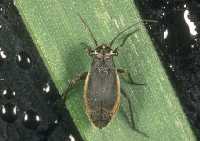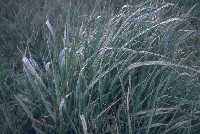by R.W. Hammon and F.B. Peairs * (8/13)
Quick Facts…
- Black grass bugs are native to western rangelands and exist at low populations on native range.
- Severe infestations are primarily associated with rangeland reseeded to introduced wheatgrasses. Problems are especially obvious on roadsides seeded with wheatgrasses.
- Black grass bugs compete directly with livestock for forage grasses and may be major problems in some areas and years.
- Cultural and chemical control measures may be effective for many seasons if timed correctly.
Black grass bugs have caused considerable damage to certain western range grasses over many years. These small black bugs are native to western rangeland, being first collected by the Hayden expedition in Colorado in 1871. The bugs apparently caused little damage to native plants before rangeland improvements were attempted. The first reports of damage to range grasses were in 1938, when many western ranges were seeded with introduced wheatgrasses. Monocultures of these grasses provided a habitat that was conducive to population explosions. Losses in heavily infested range may exceed 90 percent of the forage. Even moderate infestations of black grass bugs may offer significant competition with livestock for rangeland forage.
Several species of black grass bugs exist in Colorado, with the most common being Labops hesperius Uhler. A second species, Irbisia brachycera (Uhler) may be locally abundant. Thirty-four species of Labops and Irbisia are known from North America. Black grass bugs are about 1/4 inch in length when mature and black in color over most of the body. L. hesperius has buff coloration on the outer margins of the wing covers. I. brachycera is jet black in color, with no markings. Immature stages are similar in appearance to the adults, but smaller.
Black grass bugs damage plants in the spring by piercing and sucking the contents of cells. Within seconds of the start of feeding, a whitish spot appears at the site from the destruction or removal of chlorophyll. The bugs begin feeding at the leaf tip and proceed downwards, feeding with the head pointing down. Most feeding is done on the upper surface of the leaf. Damaged leaves may appear straw colored, as if they have been damaged by frost. Certain amounts of damage to the leaves seem to repel cattle or make the grass unpalatable. Heavy infestations may prevent seed formation, and black grass bugs often are pests of grass seed production fields. Most damaged plants will eventually recover if there is adequate moisture, but drought conditions coupled with severe black grass bug damage may cause some plant mortality.
The host range of black grass bugs is quite broad. They feed primarily on grasses, but will feed on some broadleaf plants in the absence of grasses.There are definite host preferences, with wheatgrasses being among the most preferred species. A time delay of four to seven years usually exists between the reseeding of a pasture and the appearance of significant numbers of black grass bugs. It appears that infestations are due to increases in populations already in an area, and not from dispersal from other areas.
 |
Figure 1: Labops black grass bug. The whitish flecking of the leaf is typical black grass bug damage. |
The life history of black grass bugs allows several management strategies to be effective. The winter is spent as an egg laid in the stems of host grasses. The eggs hatch in the spring when the grasses begin to grow. Egg hatch occurs early in the spring at lower elevations, and progressively later at higher elevations. One generation of black grass bugs is produced each
year. Nymphs feed and molt five times before becoming adults. It usually takes four to five weeks from egg hatch to the appearance of adult insects. Bug numbers begin to decline about four weeks after adults appear as they lay eggs and then die. The time span of the population is regulated by temperature, with adults maturing more quickly at higher temperatures. Most
females in a population do not have fully developed wings, which means they do not readily disperse to and colonize new areas.
It is important to identify an infestation of black grass bugs early in the spring so chemical control measures may be applied before extensive damage is done or egg laying begins. insecticides will kill the adult bugs but will have no effect on eggs laid in grass stems. If enough eggs are present, a reinfestation may occur in the next growing season. One well timed
application of insecticide may reduce bug numbers to a non-economic level for many years. If control is successful, the insecticide cost is spread over many years. Several insecticides are labeled for black grass bug control on rangeland and grass seed production.
 |
Figure 2: Grass severely affected by black grass bug feeding. Note the general whitish appearance of the foliage. |
Timely grazing or burning dead grasses in the fall are management techniques that destroy black grass bug eggs and may limit the need of chemical control. Graze wheatgrasses heavily for a short time in the late fall or early spring of each year. Wheatgrass pastures that are not fully utilized by grazing or haying provide egglaying sites, winter protection, and
a habitat that favors black grass bug survival. Mowing and removal of hay may be a management technique for reducing the number of eggs in some circumstances.
Black grass bugs will move into wheat planted adjacent to infested areas. Movement is usually limited to field edges closest to the source of bugs, with field centers rarely infested. Damage to the wheat appears as a whitish stippling on leaf sites where bugs have fed. Wheat plants usually are able to sustain quite a bit of black grass bug feeding without significant loss in yield. The yield loss to wheat is correlated to the extent of damage to the flag leaf. Once the flag leaf is damaged, the damage is irreversible. Wheat that is stressed by moisture, fertility or other pests will be affected more severely.
*R.W. Hammon, Colorado State University research associate, and F.B. Peairs, Colorado State University Extension entomologist and professor; bioagricultural sciences and pest management. 12/96. Revised 8/13.
Colorado State University, U.S. Department of Agriculture, and Colorado counties cooperating. CSU Extension programs are available to all without discrimination. No endorsement of products mentioned is intended nor is criticism implied of products not mentioned.
Go to top of this page.





